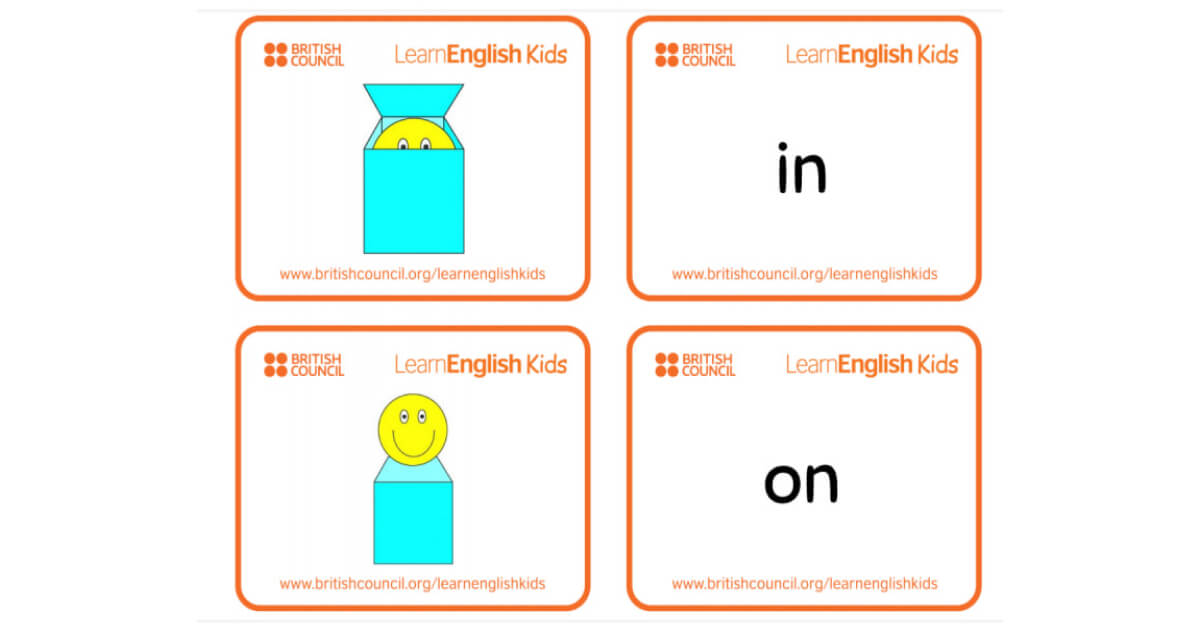Best board games for teaching and learning English
- Speaking
- Vocabulary
- Activities
- Tips & Strategies
- Methodology

20.12.2024
Teaching prepositions can’t be called the easiest. From the very beginning of the study, students often struggle with building up a reliable system of using prepositions. It doesn’t get easier when they reach higher levels because they start discovering phrasal verbs.
However, are there any ways to explain prepositions more effectively and what is more, make this topic fun and beloved? The answer is yes.
So, in this article, we are going to discuss nine engaging preposition games and activities.

Be ready to deal with any challenges ESL/EFL classroom
Study with our course!Before explaining the peculiarities of using prepositions, it is crucial to make sure that students know what prepositions are and why they are so important. So, let us start with the definition and some functions.
A preposition is a word that creates a connection between the sentence’s components.
We may even call it a glue that holds the parts of a phrase together, assisting in the development of context and meaning. Prepositions come in a variety of forms and can be used to express time, location, direction, manner, and more.
Without the right prepositions, sentences can become confusing and hard to comprehend. Moreover, knowing which preposition to choose while speaking or writing shows an improvement in general language skills as pretty often the correct option is not obvious due to the fact that the phrase or the sentence can’t be translated literally.
Make your class more student-centered
We have already mentioned that prepositions may be different and may play various roles. Here is a short table on preposition types:
| Preposition Type | Functions | Examples |
| Preposition of time | describe the time an event occurred, is occurring, or could occur. Any date, day, hour, month, year can be used. | on, at, during, etc. |
| Preposition of movement | indicate the direction in which the action happens, however, they might be challenging to comprehend and use. | toward, to, by, etc. |
| Preposition of manner | describe how something occurs or in what way it is done. | with, by, etc. |
| Preposition of place | identify the location of an action, so it is simpler to keep track of where events take place. | at, by, in, on, etc. |
| Preposition of source | show where an event started or how it originated. | by, from, etc. |
| Preposition of measure | inform about something’s quantity or quality. | by, of, etc. |
| Preposition of possession | suggest ownership of things. | of, with, to, etc. |
| Preposition of an agent of instrument | put an emphasis on something or someone accepting responsibility. | with, by, etc. |
Knowing how to teach prepositions is an important task, but the most crucial aspect is understanding why students make certain mistakes while learning them. Here are some of the most common reasons:
Various languages have different numbers of prepositions since not all languages are created in the same way and according to the same rules.
Because of this, prepositions in English frequently lack a direct equivalent in the learners’ original language which becomes a source of confusion.
Prepositions are challenging to master partially because students are unfamiliar with the words that correspond to different prepositions. The tendency of words to appear alongside other words is natural for any language and is known as collocation.
Prepositions frequently appear in conjunction with other words in English, therefore English language learners who are not aware of these collocations are more likely to make mistakes.
Preposition mistakes and difficulty in learning can both be brought on by fossilization, a process in which language learners form habits of using poor language.
The problem here is that these habits are difficult to break.
Learn more about potential problems
The easiest way to teach the various prepositional forms is to break them up into manageable chunks so that students are not overloaded with information.
Mix prepositional phrases with other pieces of vocabulary and make sure students learn and practice them gradually.
Prepositions are notoriously difficult to master because learners frequently lack understanding of the words that naturally go together with the prepositions.
While native English speakers automatically know which prepositions go with which words due to their extensive exposure to the language, it is not as easy for people learning English as a second language.
Getting students to read a lot is a great method to help them learn how certain prepositions are used.
Students must be exposed to a vast variety of understandable and age-appropriate engaging texts in order to gain a more precise idea of how prepositions should be combined with other words.
Using a lot of reading is proven to be effective as it allows students to see prepositions in their “natural habitat”.
On using authentic materials
Students can understand the meanings of various prepositions quicker by using movement and visual aids. There are plenty of different flashcards ideas on how to create visually appealing materials for your lesson on the Internet. You can use the ideas of other professionals or prepare your own worksheets. Here are some examples of what you can do:

Flashcards by British Council
Finally, with our present technologies there are so many ways to create and conduct amusing and engaging preposition games for children and adults alike. By using games in teaching prepositions to ESL students, you make them students actively interact with the prepositions and in this way really remember how to use them correctly. And now let’s look at some fun games for prepositions you can implement in your lesson plan.
Discover the best games to recycle vocabulary!
Equipment/ resources: A bar/table, enough space to play
Time: 5–6 min.
Age group: young learners
Short description: A vocabulary-related game where students are supposed to show different prepositions with their moves.
To play this game for prepositions, you need to divide children in pairs and set a bar or a desk in front of every pair.
Once everything is prepared, students move into a position that represents the preposition you name. Students can use their posture, gesture, the bar or table as they wish in order to show the phrase as quickly and accurately as possible.
The aim is to be the quickest in coming up with the appropriate presentation. The group that solves the task the last leaves the game.
In this way, only students with the strongest knowledge of prepositions continue playing till the end. Make sure you start with the easiest collocations and gradually implement more and more difficult phrases.
Equipment/ resources: Some everyday objects that you are supposed to rearrange.
Time: up to 15 min.
Age group: most appropriate for younger learners
Short description: Students look for the missing objects and note where exactly the objects have been found using the correct prepositions.
Teachers may tell the students that they have a ghost in the classroom. The ghost has rearranged many different classroom objects and put them around the classroom. Now students are supposed to find missing objects and return them to the usual places.
You divide students into pairs and give them a list of objects they need to find (you may also skip this step and let the students spot the differences on their own without the help of the keys).
While looking for the objects, students also have to make notes about where exactly they have found the object and where they are going to return it. In this way you get a fun activity to revise prepositions, especially prepositions of place.

Fun games to improve vocabulary
Discover in the articleEquipment/ resources: Materials to note and sketch for the students
Time: up to 10 min.
Age group: any
Short description: Students create a detailed description of their ideal room (or even house) using the correct prepositions.
Ask your students to describe their dream living room or bedroom or any other room to one another in pairs.
To provide an interior design, ask them to write a detailed piece of information about their dream houses using prepositions of place. You might ask the students to design the whole house or just one or two rooms.
They might also face a situation where they need to compromise during the design process because they are working in pairs for this assignment. Ask them to use as many prepositions as they can.
Equipment/ resources: Link for a game
Time: up to 10 min.
Age group: mostly young English learners
Short description: Students play a game where they try not to become a prey of a dinosaur by using correct prepositions.
Bring dinosaurs to the class to make teaching prepositions more enjoyable 🙂 Both young learners and adult students can benefit from playing these kinds of games for prepositions.
It was created to teach students to use such prepositions of time and place as at, by, on, since, in, for, and to. The game is initiated by the students clicking on the dice that are displayed on the screen.
Every right response defends the player from the dinosaurs, which are scattered across the game screen. Therefore, the learners are motivated to be accurate with their responses.
How to become a motivation guard?
Equipment/ resources: Link for a game
Time: up to 15 min.
Age group: any
Short description: Students play a game where they need to carefully listen to the instructions and drag the objects to the places where the instructions tell them to.
The players are supposed to actively interact with the prepositions as they listen to the instructions and place the object where they are meant to be according to the instructions.
By completing such kinds of prepositions games and activities, students get a good sense of how to appropriately use the preposition of place in spoken and written English. The game also helps young English learners’ vocabulary growth in addition to upgrading their skill of using prepositions.
Equipment/ resources: Materials for the students to draw
Time: up to 10 min.
Age group: any
Short description: Students draw the picture listening to the instructions with a big amount of prepositions.
Use prepositions to direct your students and help them with creating an image. Don’t reveal what they are sketching.
Also, try not to make the image predictable and increase the difficulty of the instructions step by step. The student who has the most accurate picture wins.
You may also turn this game into a pair activity. Students can use prepositions to give instructions to their partners and check if they got the correct picture after.
Equipment/ resources: Any classroom objects that the majority of the students have
Time: up to 10 min.
Short description: Students listen to and correctly follow the instructions which start from the phrase “Simon says”. The instructions should contain a lot of prepositions.
Ask your kids to select a common object that everybody in the room has and can use. You may pick a chair, a pencil, or a book.
Prepositional Simon Says doesn’t differ much from the normal one, but while giving instructions, explain the player’s location in connection to the object you have selected by using a preposition. You may ask someone to do the following, for instance:
“Simon says to put your pencil under the book.”
“Simon says stand behind your chair.”
Similar to the traditional game, if someone obeys an order that is not followed by “Simon says,” they are eliminated. Students also need to listen to the instructions carefully because if they make a wrong move they lose.
Equipment/ resources: Cards with the prepositions, enough of space to move freely.
Time: up to 10 min.
Age group: mostly young learners
Short description: Students listen to the sentences and decide which preposition they need to choose. Once they have decided, they need to run to the corner named after the appropriate preposition.
Start by naming each corner of the classroom with a separate preposition. You can focus on phrasal verbs, locational prepositions, or any other kind.
Push the furniture out of the way and instruct your students to stand in the middle of the room. A phrase can be used by reading it loudly or projecting it on the screen. The preposition in the sentences should be replaced by any word, for example, the word “corner”.
After hearing the statement, students have to sprint to the correct part of the room to logically finish the sentence.
For instance, you might say something like: “My pen is CORNER the table” (with “on” as the desired response). Students who choose an incorrect corner are eliminated. Students are supposed to play till one winner is left.
Ideas on how to make lessons more engaging
If you want to make your lessons truly unforgettable, we highly recommend exploring the English teacher training courses available on the grade-university.com.
These online courses give you the flexibility to study whenever and wherever it suits you.
Additionally, free demo versions are available, allowing you to preview the materials before committing to the training.
Enhance your teaching skills to the fullest and acquire professional expertise today!
Equipment/ resources: 5-10 everyday classroom objects
Time: up to 15 min.
Age group: any
Short description: Students are supposed to spot and describe the change in the order or location of the objects after the teacher changes them.
Place a tray or desk in the center of the room for a start. Five to ten objects are usually enough, however, mind that the difficulty of the exercise increases with the number of objects you have.
Give your students a minute or two to examine the items on the tray. Then cover it up and either relocate or take away one item. Present the tray to your students once more.
They have to figure out what is different and describe what exactly changes by using the prepositions. Maybe the apple used to stand between the orange and the banana, but now the order is different. The most attentive and the most accurate students win.
You can also make this game harder by removing one object and moving two or more other objects.
For a change, you may also make it a pair work where one person arranges the objects and another describes the changes.

Teach comparatives in a fun way!
Learn howPrepositions are one of the easiest topics to teach.
It is a good idea to make tasks on prepositions as visual as possible.
Arina Kravchenko
Author
Teacher of General English & IELTS
Comments
Leave your comment